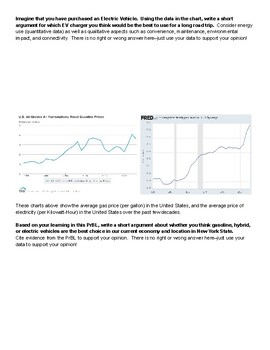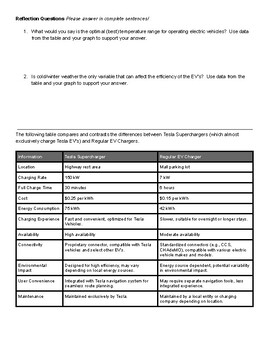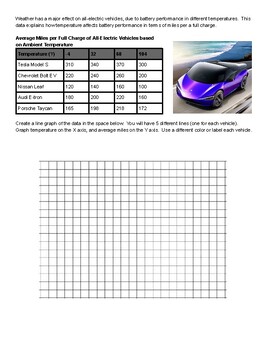Physics PrBL: Cars: Mechanical Advantage, Efficiency, and Power Problem Based
Jake's Science Corner
44 Followers
Grade Levels
10th - 12th, Homeschool
Subjects
Resource Type
Standards
NGSSHS-PS3-2
NGSSHS-PS3-1
Formats Included
- PDF
Jake's Science Corner
44 Followers
Description
In this Physics Problem-Based Learning Activity students will:
- Read about mechanical advantage, efficiency and power in cars and respond with short-answer reading comprehension questions.
- Examine data of miles per gallon/miles per charge to compare & contrast gasoline engines vs. hybrid an all-electric vehicles.
- Graph data around temperature and battery performance of all-electric vehicles.
- Respond to trends and patterns in data surrounding the rising cost of electricity and fossil fuels.
- Create short argumentative essays based on their data and responses determining the advantages and disadvantages of each vehicle type.
Includes an answer key. Note: Some answers are opinion-based and will vary based on how students interpret the data. A basic knowledge of reading charts/line graphs is recommended.
Note - Parts of this activity have been A l generated. This has been teacher-tested for accuracy.
Total Pages
Answer Key
Included
Teaching Duration
N/A
Report this resource to TPT
Reported resources will be reviewed by our team. Report this resource to let us know if this resource violates TPT’s content guidelines.
Standards
to see state-specific standards (only available in the US).
NGSSHS-PS3-2
Develop and use models to illustrate that energy at the macroscopic scale can be accounted for as a combination of energy associated with the motion of particles (objects) and energy associated with the relative position of particles (objects). Examples of phenomena at the macroscopic scale could include the conversion of kinetic energy to thermal energy, the energy stored due to position of an object above the earth, and the energy stored between two electrically-charged plates. Examples of models could include diagrams, drawings, descriptions, and computer simulations.
NGSSHS-PS3-1
Create a computational model to calculate the change in the energy of one component in a system when the change in energy of the other component(s) and energy flows in and out of the system are known. Emphasis is on explaining the meaning of mathematical expressions used in the model. Assessment is limited to basic algebraic expressions or computations; to systems of two or three components; and to thermal energy, kinetic energy, and/or the energies in gravitational, magnetic, or electric fields.





